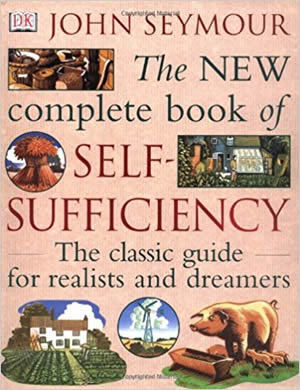The classic guide for realists and dreamers. That’s the subtitle of John Seymour’s classic The New Complete Book of Self-Sufficiency. I’m a bit of both. My dream is having a small farm, around five acres, with cereals, vegetables and fruit, as well as some livestock to provide me with meat, eggs, dairy and, of course, manure. On top of that I’d like to build and fix as much as possible on my own, preferably using materials that I don’t need to go to the store to get. Seymour, in this book, covers all of that — and much more.

The realist in me tries to focus on the yard outside our house. I’m trying to convert it to a vegetable garden, and I couldn’t have asked for better instructions than those of Seymour — a man who spent most of his 90 years on Earth working with the land and using materials found in real forests rather than on Amazon.
The Complete Book of Self-Sufficiency was first published in 1976, and even this new edition might seem to offer little for present-day farmers, whether their holding is 5,000 acres or a fourth. But the skills and methods that Seymour talks about were, in many cases, already old when he wrote this book, so for those interested in learning these perennial ways, it is still relevant today. On only a few (of the quite large) pages in this 400-page book did I come across anything truly outdated. But it is important to stress this: The point of using these methods is not to live in an old-fashioned or “off-the-grid” way. It’s living a simpler life with nature as a companion. For Seymour, modern life, especially city life, is very far from that, but even when it comes to farming, modern methods have made nature the subject rather than the friend of mankind. For the most part, old and proven methods are the best tools for true husbandry, and that is what I care about.
In 10 chapters, ranging from “The Meaning of Self-Sufficiency” to “Energy & Waste” (including two pages on the dry toilet, which will not be taken up at my house any time soon), the author describes hundreds of practices in varying amounts of detail. More than a quarter of the book focuses on “Food from the Garden,” in which the reader learns smart tricks that can be used for many plants, including how to keep away pests and disease in an organic way. He also dedicates plenty of space to explaining techniques for just one plant — and then goes on to varieties of that plant. For instance, he gives specific advice for five different types of beans!
- Related articles
- Home Grown
- Sustainability, Stewardship and Hands-on Horticulture
- Foods, Farm and Family
- Part-Time Bee Keeper
- Redefining Fast Food
- A Deep Connection with the
Earth
The detailed advice for specific plants — and other subjects — as well as the organized way in which it is presented makes The New Complete Book of Self-Sufficiency a great book to read and then use as a reference work. It has already helped me a few times, with advice for composting, cutting down trees and digging my garden. I doubt that this book will ever collect dust.
It is remarkable that Seymour mastered so many skills and can explain them to others as well. For instance, he also covers woodworking, building houses and making an efficient watermill. He describes tasks such as churning butter, making cheese and yogurt, conserving food (both meat and the vegetables that you have harvested during the warmer months). He even includes recipes.
Seymour’s humor is often on display. When he describes how to make whisky, using a copper pot, a basin and a dish, he also suggests that “if distilling is illegal in your part of the world and some inquisitive fellow comes down the drive, it doesn’t take a second to be boiling clothes in the copper, making porridge in the floating basin and bathing the baby in the big flat dish. And what could be more innocent than that?”
On occasion, I had no clue what Seymour was talking about. Luckily his book is rich in beautiful and helpful illustrations, making abstract ideas much more comprehensible. And I guess that is the point of this book. Being self-sufficient can be a theoretical idea. What does it even mean, to what degree should you do it, and how do you do all the things that it involves? I don’t feel ready to quit my day job after reading this book — after all, being a smallholder involves so much work that it is impossible to explain everything in complete detail in 400 pages. But this will certainly help me with this year’s vegetable garden, and now I have an idea of what I need to learn more about.
Seymour’s book is a bit like a bible; it covers everything, and it’s the first thing I’ll look to in the future. But I will also need “theologians” to dig deeper, so to speak, into particular types of work that I still have questions about.
Rasmus Schmidt Jorgensen is a student at the Danish School of Media and Journalism and an intern at this magazine; email rschjorgensen@gmail.com.